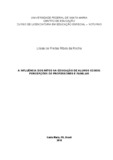| dc.contributor.advisor | Pereira, Josefa Lídia Costa | |
| dc.creator | Rocha, Lísias de Freitas Ribas da | |
| dc.date.accessioned | 2019-01-14T10:57:58Z | |
| dc.date.available | 2019-01-14T10:57:58Z | |
| dc.date.issued | 2018-12-10 | |
| dc.date.submitted | 2018 | |
| dc.identifier.uri | http://repositorio.ufsm.br/handle/1/15328 | |
| dc.description | TCC de Graduação | por |
| dc.description.abstract | The human being is constituted by experiences and social relations established
along its path with its group, therefore, the influence of certain patterns that end up
ruling the society, manifests itself through interactions between individuals, thus, the
stigmas and myths became influences when manifestedby groups. The objective of
this research is to analyze how the teachers and the family perceive the influence of
myths in visually impaired students. For this study was chosen a qualitative
language, with field research. The participants of this research were relatives and
teachers of five visually impaired students of two municipal elementary schools of
Santa Maria/RS. This study sought to understand how the myths influence the
education of students in a broader perspective, maybe this influence in their school
performance as well as on social interactions. For this purpose, an interview script
was applied as an instrument semistructured with responsible and teachers. Thus, it
is understood that myths exist and its influence still remain present, even though
subtly, through attitudinal barriers the way how the society act in relation to the
visually impaired person and how this action can interfere in the student
development, being able to cause damage in their adulthood making impossible to
have a independent and an autonomous life. It is expected that this research could
contribute with the area, bringing information thatclarifies those who still have some
apprehension about the visually impaired person condition. | eng |
| dc.language | por | por |
| dc.publisher | Universidade Federal de Santa Maria | por |
| dc.rights | Acesso Aberto | por |
| dc.rights.uri | http://creativecommons.org/licenses/by-nc-nd/4.0/ | * |
| dc.subject | Deficiência visual | por |
| dc.subject | Mitos | por |
| dc.subject | Família | por |
| dc.subject | Educação especial | por |
| dc.subject | Visual impairment | eng |
| dc.subject | Myths | eng |
| dc.subject | Family | eng |
| dc.subject | Special education | eng |
| dc.title | A influência dos mitos na educação de alunos cegos: percepções de professores e familiar | por |
| dc.title.alternative | The influence of myths in the education of blind students: teachers and family perceptions | eng |
| dc.type | Trabalho de Conclusão de Curso de Graduação | por |
| dc.degree.local | Santa Maria, RS, Brasil | por |
| dc.degree.graduation | Curso de Licenciatura em Educação Especial Noturno | por |
| dc.description.resumo | O ser humano é constituído por experiências e relações sociais estabelecidas ao
longo de seu percurso junto ao seu grupo, assim, a influência de determinados
padrões que acaba regendo a sociedade, manifesta-seatravés das interações entre
os indivíduos, sendo que, estigmas e mitos tornam-se influenciadores quando
manifestados pelos grupos. O objetivo dessa pesquisa é analisar como os
professores e o familiar percebem a influência dos mitos na educação de alunos
cegos. O presente estudo será apresentado através de uma abordagem qualitativa,
com pesquisa de campo. Os participantes dessa pesquisa foram familiares e
professores de cinco alunos cegos do ensino fundamental de duas escolas
municipais de Santa Maria/RS e busca compreender como os mitos influenciam a
educação dos alunos em uma perspectiva mais ampla, podendo ser essa influência
em seu desempenho escolar como também em interações sociais. Para tanto, foi
aplicado como instrumento de pesquisa um roteiro de entrevista semiestruturado
com responsáveis e professores. Sendo assim, entende-se que mitos existem e
suas influências ainda permanecem presentes, mesmo que sutilmente, através das
barreiras atitudinais o modo como a sociedade age em relação à pessoa cega e
como esta ação pode interferir no desenvolvimento do aluno, podendo causar danos
em sua fase adulta impossibilitando-o de ter uma vida independente e autônoma.
Espera-se que esta pesquisa possa contribuir com a área, trazendo dados que
esclareçam aqueles que ainda possuem algum receio quanto à condição da pessoa
com deficiência visual. | por |
| dc.publisher.country | Brasil | por |
| dc.publisher.initials | UFSM | por |
| dc.subject.cnpq | CNPQ::CIENCIAS HUMANAS::EDUCACAO::TOPICOS ESPECIFICOS DE EDUCACAO::EDUCACAO ESPECIAL | por |
| dc.publisher.unidade | Centro de Educação | por |



